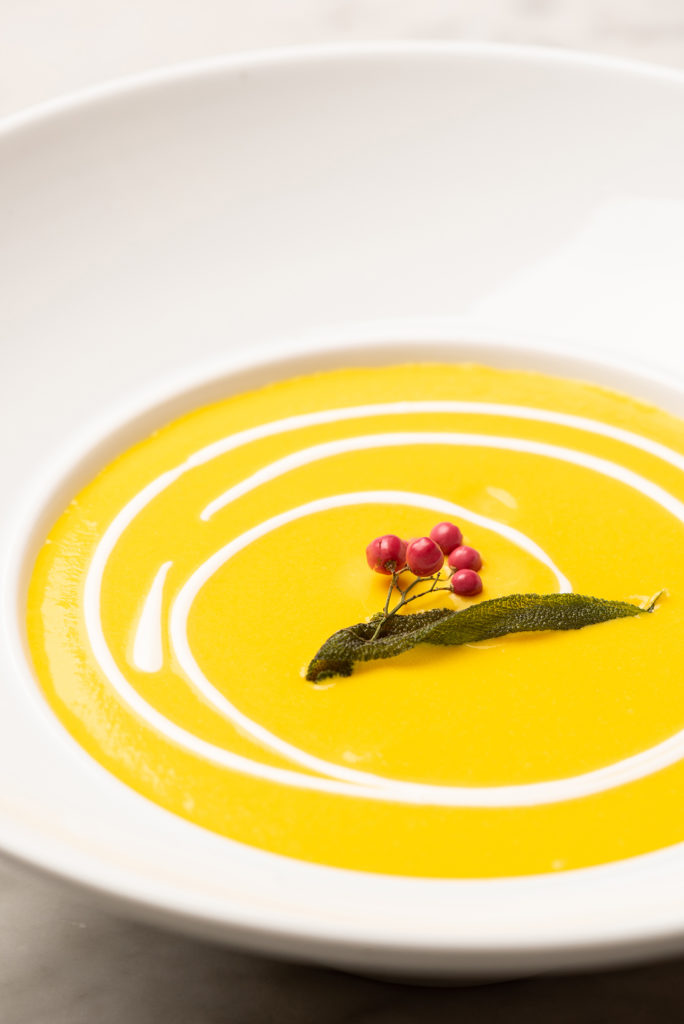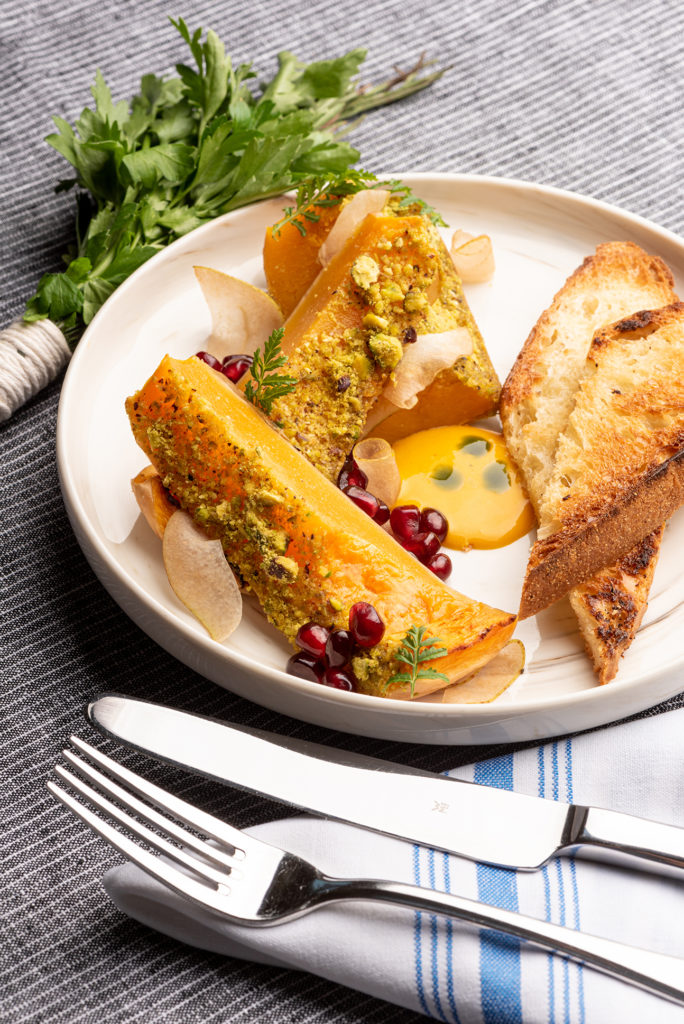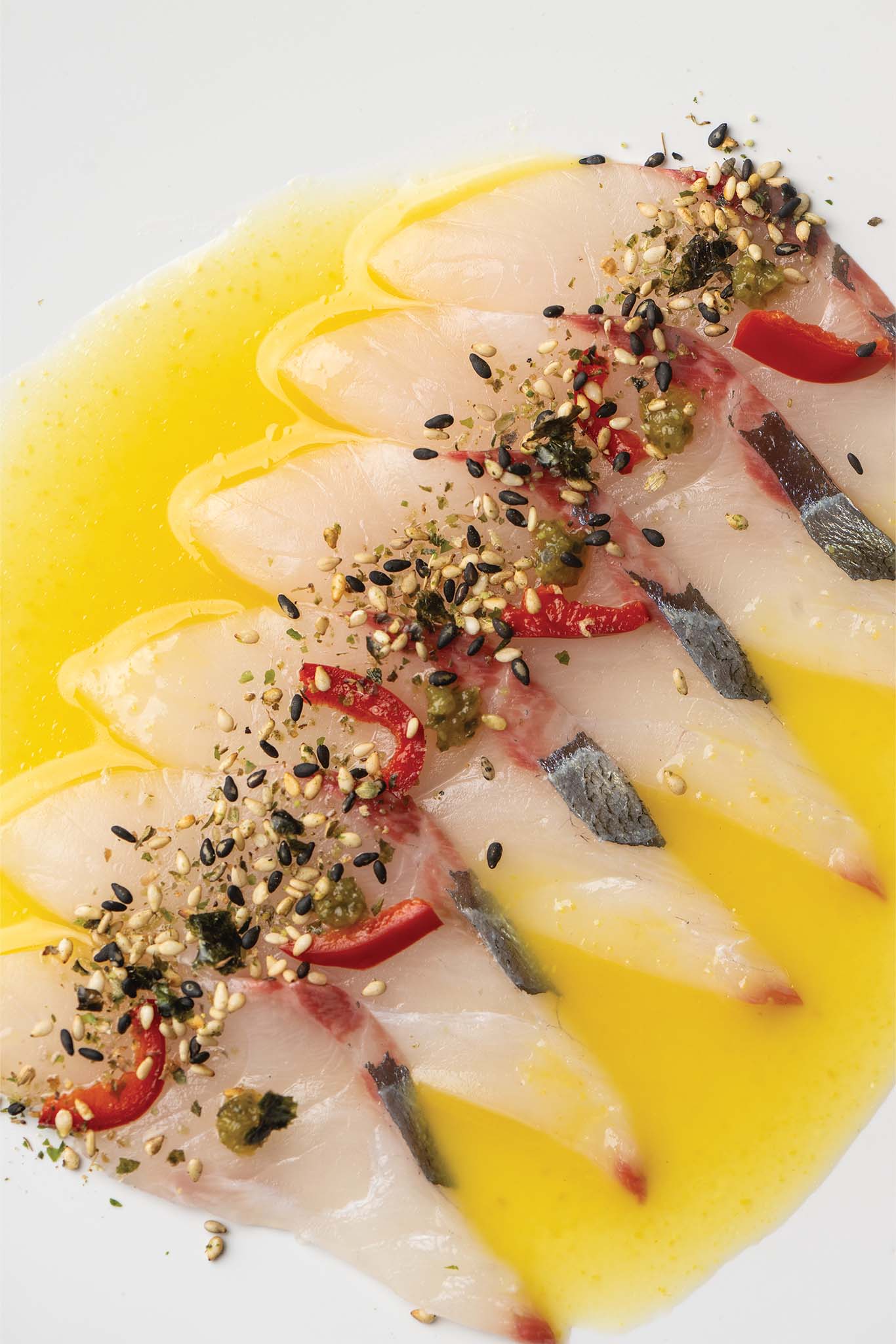Text by With a Net
Images by Wonho Frank Lee
Wander into any farmer’s market this time of year and you will make the acquaintance of more than a dozen hearty varietals of winter squash. Harvested in the fall, the best ones are blemish- and bruise-free, have a stem, and feel heavy for their size.
Winter squash is a terrific source of beta carotene, magnesium, potassium, and manganese. Many varietals also contain vitamins B6, C, and E. Low in fat and calories, the mild-to-sweet flavor will not overwhelm your seasonal dishes. Due to how squash is used by chefs around the world, it is often mistaken for a vegetable. However, it contains seeds and develops from the flowers of a plant, which means that botanically it is classified as fruit.
The Executive Chef of Shutters on the Beach, Vittorio Lucariello, loves this time of year, finding squash’s versatility, texture, and color perfect for his fall and winter menus. Here are three of his team’s favorite ways to prepare this sometimes savory, sometimes sweet, always comforting ingredient.
Burrata with Maple Roasted Butternut Squash, Prosciutto di Parma, Pomegranate Balsamic Reduction
“Butternut squash is sweet with a rich orange flesh and contains very few seeds,” explains Chef Vittorio, who hails from Italy. “I have often used it for ravioli filling or to flavor risotto. However, it is especially delicious when roasted and served with a favorite burrata and prosciutto.”
Ingredients
4 4-ounce balls of burrata cheese
12 slices of Parma Prosciutto
6 cups cubed butternut squash (1/2’’ cubes)
4 tsp olive oil
½ cup pure maple syrup
1 tsp salt
3/4 tsp pepper
A pinch of cinnamon
1 ½ cups balsamic vinegar
1 ½ cups pomegranate juice
4 Tbsp unsalted butter
10-12 sage leaves
1 cup pomegranate seeds
Instructions
Preheat oven to 400˚. Line a rimmed baking sheet with parchment paper. Add butternut squash, olive oil, maple syrup, salt, pepper, and cinnamon to a mixing bowl. Toss to coat. Transfer to the prepared baking sheet and roast for 20 minutes or until tender.
While the butternut squash is roasting, add the balsamic vinegar and pomegranate juice in a saucepan over medium-high heat and bring to a boil. Boil for 10-12 minutes or until it has reduced to a quarter of its volume and is syrupy like a glaze. Set aside.
In a medium saucepan, melt the butter over medium-high heat. Once melted and beginning to bubble, add the sage leaves and fry for 30 seconds to 1 minute, lowering the heat if the butter starts to brown too quickly. Remove the sage leaves from the pan and let drain on paper towels. Reserve the butter for drizzling.
To assemble, place butternut squash on a plate and place burrata on top. Drizzle with the balsamic pomegranate glaze, place the Prosciutto di Parma on top with the fried sage leaves and the pomegranate seeds.
Drizzle with the leftover sage brown butter. Season with a pinch or two of sea salt. Serve with baguette toast. Serves four.
Kabocha Squash Soup
“Kabocha is my favorite for soups. Selecting the right kabocha at the marketing is key,” Chef Vittorio advises. “Look for one that is firm and has a deep green rind, the rind is edible and full of fiber. You’ll also want to find one that’s heavy for its size, about 2 to 4 pounds.”

Ingredients
½ onion, thinly sliced
1 medium kabocha squash
1 Tbsp unsalted butter
2 cups chicken broth
1 ½ cups whole milk
½ cup heavy cream
2 tsp kosher or sea salt (use half if using table salt)
Freshly ground white pepper
Chopped parsley
Instructions
Cut kabocha in half, scoop out and discard seeds. Cut into six wedges. Remove the skin and cut into small equal-sized cubes.
In a pot, heat the butter over medium heat, add onion and cook until soft and brown. Add the kabocha and sauté to coat with butter.
Add the chicken broth and bring to a boil. Once boiling, reduce the heat and simmer for 12-15 minutes.
Test squash for doneness; it should be soft.
Puree the soup in batches in blender or puree with an immersion blender until smooth and return to pot. Add the milk and heavy cream and stir until combined. Season with salt and white pepper and stir over moderately low heat until hot.
Ladle the squash soup into bowls, garnish with the chopped parsley and serve. Serves four.
Recipe notes
If you use regular salted butter, reduce the amount of kosher salt.
Heavy cream can be replaced with non-fat milk if desired.
Whole Roasted Honeynut Squash with Two Sauces
“Honeynut squash was cultivated by the Plant Breeding and Genetics Lab at Cornell and found its way to chefs’ kitchens around 2015,” says Chef Vittorio. “When selecting a honeynut squash, look for one that has the least amount of green. It is a mini version of a butternut squash and is hearty and flavorful enough to be served as an entree.”

Ingredients
1 medium honeynut squash
2 Tbsp maple syrup
1/4 cup chopped pistachios
1/4 cup pomegranate seeds
Sauce 1:
1 cup almond milk
1 Tbsp curry power
Pinch of saffron
1 tsp tangerine juice
Sauce 2:
2 medium pears, or 1 pear and a fruit of your choice, thinly sliced
½ cup tangerine juice
Instructions
Heat oven to 425˚. Wash and lightly season whole uncut squash with olive oil and salt. Puncture the skin several times for steam release. Place on baking sheet or pan and roast for 1 hour or until you can pierce squash easily with a steak knife.
Prepare sauces. Sauce 1: Heat almond milk on medium until it reduces, about 15 minutes. Stir in curry powder, saffron, and tangerine juice. Season with salt and reduce until desired consistency. Sauce 2: Marinate fruit in tangerine juice for 15 minutes. Strain and add fruit in bowl with squash.
Remove squash from oven and let cool. Cut squash in half lengthwise and scoop out and discard hot seeds. Carefully baste the cut side of the squash with maple syrup. To serve in squash skin, sprinkle chopped pistachios on top. To serve on dishes, scoop squash out of skin into shallow bowls first and then sprinkle with pistachios.
Add the sauce of your choice, or both, and sprinkle with pomegranate seeds and serve.









